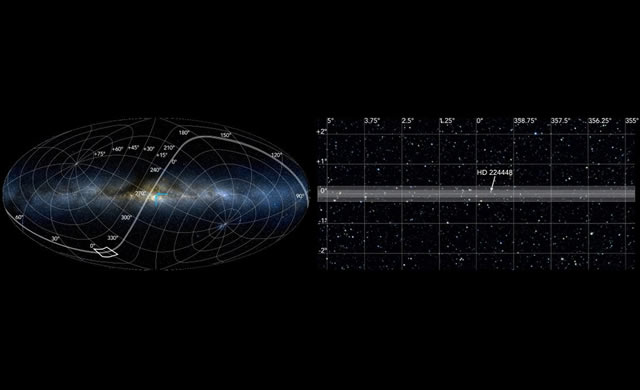
Jodie Foster – “Contact” Carl Sagan
E.T. parla, ma nessuno lo ascolta – Un nuovo approccio alla ricerca di vita extraterrestre intelligente. Come gli astronomi vanno a caccia di esopianeti facendo affidamento sul sistema dei transiti, allo stesso modo una civiltà aliena potrebbe aver individuato la Terra grazie al movimento di rivoluzione attorno al Sole, la nostra stella. L’ipotesi in uno studio della McMaster University in uscita su Astrobiology.

Cosa succederebbe se E.T. fosse stufo di stare attaccato a un ricevitore, mentre qui, da noi, il telefono suona a vuoto e nessuno risponde? La domanda al limite della realtà se la sono posta i ricercatori della McMaster University: non va escluso che l’intelligenza extraterrestre esista e stia cercando di mettersi in contatto con noi. Meglio prestare bene attenzione ai deboli segnali che giungono alle nostre orecchie elettroniche dalla periferia della Galassia. Sarebbe un peccato trovarsi fuori campo mentre una forma intelligente di vita extraterrestre cerca di mettersi in contatto con noi. Il punto di partenza è elementare: René Heller e Ralph Pudritz della McMaster sostengono che la concreta opportunità di trovare un segnale proveniente dall’esterno si basi sulla condivisibile considerazione che E.T. stia cercandoci con gli stessi strumenti in nostro possesso. Qui da noi, sulla Terra, astrofisici e ricercatori stanno concentrando i loro sforzi su pianeti e lune troppo lontani perché possano essere visti direttamente. Lo studio degli esopianeti passa dal monitoraggio dei transiti di questi lontani corpi celesti di fronte alla loro stella ospite.
Se E.T. va a caccia di esopianeti come facciamo noi, e se per farlo si affida al metodo dei transiti, allora è meglio prestare bene attenzione ai posti da cui si ha una bella vista sul Sole e transito della Terra sul disco solare. «È impossibile sapere se gli extraterrestri utilizzino o meno le nostre tecnologie per scrutare l’Universo», spiega Heller. «Certo devono fare i conti con gli stessi principi fisici che valgono per noi, e il sistema dei transiti è un buon metodo per portare a casa validi risultati». Ora, la zona di transito della Terra sul disco del Sole si offre a un pubblico di circa 100mila potenziali bersagli. Un numero destinato a crescere mano a mano che la nostra capacità di osservare il cielo viene incrementata e migliorata. «Se qualcuno di questi bersagli ospita vita intelligente, ebbene questa potrebbe averci individuati da tempo e un eventuale messaggio dallo spazio potrebbe essere già stato trasmesso in direzione Terra», spiega Pudritz. Resta da capire se la telefonata da E.T. sia o meno già arrivata alle nostre orecchie. Speriamo di saper prestare la giusta attenzione a questi deboli segnali interstellari.
Fonte/Leggi tutto → Media.Inaf.it
Over the past few years, astronomers have detected thousands of planets and candidate planets by observing their periodic transits in front of their host stars. A related method, called transit spectroscopy, might soon allow studies of the chemical imprints of life in extrasolar planetary atmospheres. Here, we address the reciprocal question, namely, from where is Earth detectable by extrasolar observers using similar methods.
#Astrobiology paper “#SETI in the Earth’s Solar Transit Zone” available athttps://t.co/u2MyngDKmT pic.twitter.com/ZGPOExP0mH
— René Heller (@DrReneHeller) 2 marzo 2016
We explore Earth’s transit zone (ETZ), the projection of a band around Earth’s ecliptic onto the celestial plane, where observers can detect Earth transits across the Sun. ETZ is between 0.520 and 0.537 wide due to the noncircular Earth orbit. The restricted Earth transit zone (rETZ), where Earth transits the Sun less than 0.5 solar radii from its center, is about 0.262 wide. We first compile a target list of 45 K and 37 G dwarf stars inside the rETZ and within 1 kpc (about 3260 light-years) using the Hipparcos catalogue. We then greatly enlarge the number of potential targets by constructing an analytic galactic disk model and find that about 105K and G dwarf stars should reside within the rETZ. The ongoing Gaia space mission can potentially discover all G dwarfs among them (several 104) within the next 5 years. Many more potentially habitable planets orbit dim, unknown M stars in ETZ and other stars that traversed ETZ thousands of years ago. If any of these planets host intelligent observers, they could have identified Earth as a habitable, or even as a living, world long ago, and we could be receiving their broadcasts today. The K2 mission, the Allen Telescope Array, the upcoming Square Kilometer Array, or the Green Bank Telescope might detect such deliberate extraterrestrial messages. Ultimately, ETZ would be an ideal region to be monitored by the Breakthrough Listen Initiatives, an upcoming survey that will constitute the most comprehensive search for extraterrestrial intelligence so far.
Source/Continue reading → www.liebertpub.com





















